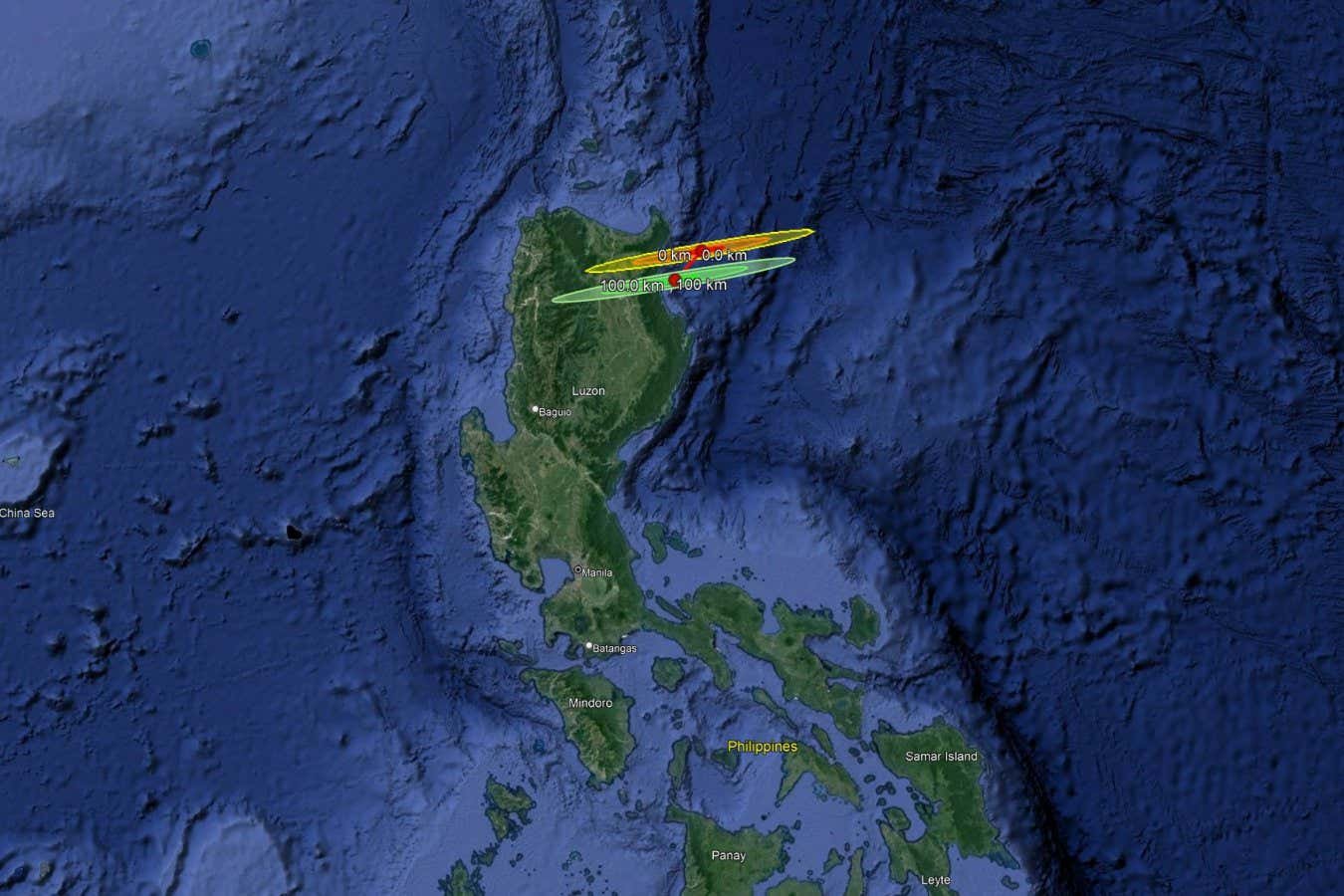
The predicted path of asteroid CAQTDL2 over the Philippines
Catalina Sky Survey/ESA
An asteroid hit Earth and burned up in the atmosphere just east of the Philippines. It was discovered by astronomers only hours before it streaked across the sky in a bright fireball, but went unseen by many on the ground as the view was obscured by cloudy weather produced by Typhoon Enteng.
The asteroid, which is estimated to be roughly 1 metre across, was spotted earlier today by the NASA-funded Catalina Sky Survey and initially given the designation CAQTDL2, before being named 2024 RW1.
As predicted, the asteroid struck Earth around 1645 GMT, or 1745 London time, 1245 New York time and 0045 local time just east of the northernmost island of the Philippine archipelago. It was expected to hit at a speed of 17.6 kilometres per second, or 63,360 kilometres per hour, which Alan Fitzsimmons at Queen’s University Belfast in the UK says is about average for such objects. “Don’t be fooled by Hollywood movies where you can see the thing coming screaming through the sky and you’ve got time to run out the house, get the cat, jump in the car and drive somewhere. You don’t have the time to do that,” he says.

The asteroid CAQTDL2 is visible moving across the sky within the purple circle
Catalina Sky Survey
Fortunately, there was no need for an evacuation: NASA’s Planetary Defense Coordination Office posted on social media that the asteroid “safely impacted Earth’s atmosphere”.
“An object this small can’t do any damage on the ground. We’re protected from them by the Earth’s atmosphere,” says Fitzsimmons. A video shared on social media shot from the province of Cagayan at the northern tip of the Philippines shows a flickering green fireball appear behind the clouds, followed by an orange tail, which disappeared just seconds later.
☄️?Woah! Newly discovered 1-1.5m asteroid 2024 RW1 (spotted by near-Earth asteroid hunters in the US) burns up above the Philippines just hours after it was first seen.
This asteroid wasn’t a risk. But if it was, a duck-and-cover warning was possible. pic.twitter.com/Fht4yqRsBP
— Dr Robin George Andrews ?☄️ (@SquigglyVolcano) September 4, 2024
Fitzsimmons says that two or three objects this size strike Earth every year and that we are increasingly able to spot them early, with the first incoming asteroid being detected by astronomers before landing in 2008. 2024 RW1 is the ninth accurately predicted asteroid strike on Earth.
“The really positive aspect about this is that the survey telescopes are now good enough to spot these things coming in and give us a bit of warning,” he says. “Put another way, if this object had been much larger and so perhaps pose a threat to people on the ground, then it would be much brighter, and we’d have projected it much further out. So this actually is a really nice demonstration that the current survey systems are doing a very good job. We’re probably averaging about one small asteroid detected before it hits the atmosphere every year now, and the survey systems are only getting better.”
Not only is Earth developing and improving its early warning system, but in 2022 NASA’s Double Asteroid Redirection Test (DART) spacecraft proved that we have a chance of saving the planet from a catastrophic impact of a larger object. DART crashed into the 160-metre-wide moonlet Dimorphos and slowed it slightly, demonstrating that, in theory, we could avert such a disaster. Next month, the European Space Agency is due to launch its Hera mission to study the results of the impact up close, and further improve our understanding of planetary defence.
Topics:

